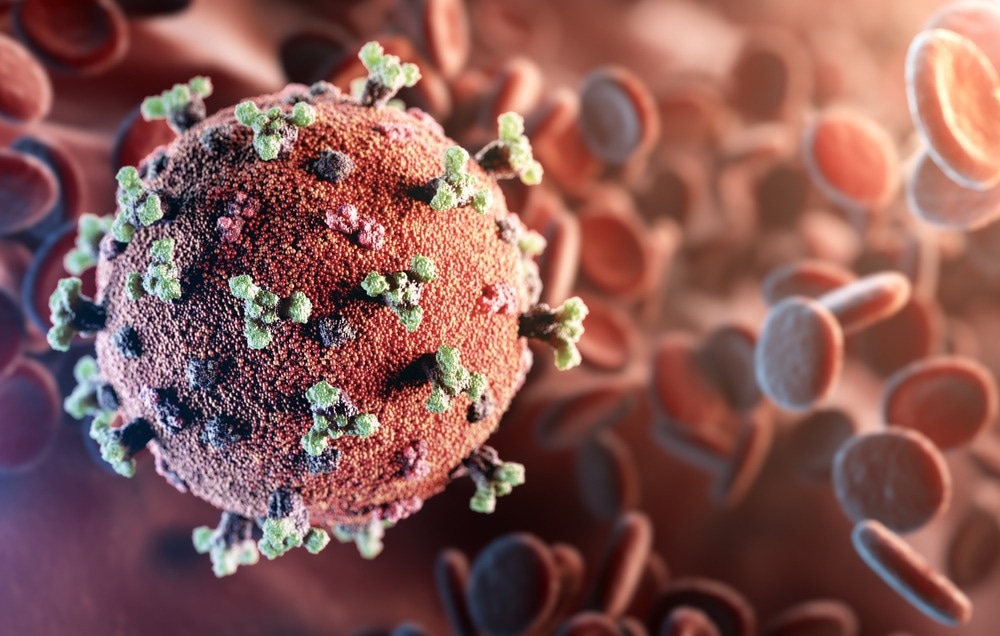 By Neha MathurReviewed by Danielle Ellis, B.Sc.Sep 8 2022
By Neha MathurReviewed by Danielle Ellis, B.Sc.Sep 8 2022In a recent study published in PLOS Pathogens, researchers screened a library of phages encoding biosynthetic proteins called αReps. They pursued αReps that could block the interaction between receptor-binding domain (RBD) of severe acute respiratory syndrome coronavirus 2 (SARS-CoV-2) spike (S) protein with the host's angiotensin-converting enzyme 2 (ACE2) receptors.
 Study: Biosynthetic proteins targeting the SARS-CoV-2 spike as anti-virals. Image Credit: creativeneko/Shutterstock
Study: Biosynthetic proteins targeting the SARS-CoV-2 spike as anti-virals. Image Credit: creativeneko/Shutterstock
Background
It is crucial to develop efficient antiviral strategies against SARS-CoV-2 to mitigate and control the coronavirus disease 2019 (COVID-19) crisis which has already resulted in over six million deaths globally. A strategy to fight the spread of all respiratory viruses is also needed to combat future pandemics.
SARS-CoV-2 initiates infection in the nasal cavity, replicates in the olfactory epithelia and lower respiratory tract (URT), and then reaches the lower respiratory tract (LRT), where it establishes infection. Since it causes massive damage in the olfactory epithelia, an antiviral blocking virus multiplication in the nose and URT could offer immense therapeutic benefits and even provide prophylactic protection.
Some human neutralizing monoclonal immunoglobulin G (IgG) antibodies inhibit SARS-CoV-2 infection in the nose and URT; however, their use is limited. Moreover, their firmness upon nebulization and aerosolization is poor. They require injection and cannot be taken orally or by spray.
αReps are 31-amino acids (AAs) long thermostable proteins commonly found in eukaryotes and prokaryotes, including thermophiles. Sequences of homologous αReps form a contrasted sequence profile, with most positions occupied by conserved AAs and the remaining positions generating a flexible binding surface. Scientists have assembled a massive αRep library with a vast collection of disparate protein targets, in particular, to interact and deleteriously interfere with virus maturation (e.g., against human immunodeficiency virus nucleocapsid protein).
The SARS-CoV-2 spike (S) protein, like the S proteins of all the coronaviruses, harbors RBD. RBD is a target to identify ligands that block interaction with the host-cell receptors. However, SARS-CoV-2 evolution has led to the emergence of explicit escape mutations in the RBD, making the current variable domain of heavy-chain antibodies (VHH)-based treatments much less effective.
About the study
In the present study, researchers developed an αRep series specific to the RBD of the SARS-CoV-2 S, which could easily adapt to work stably against SARS-CoV-2 variants at a low cost. The researchers used a previously established method to construct the αRep library that relied on the polymerization of synthetic microgenes corresponding to individual HEAT-like repeats. They used the surface of M13-derived filamentous phages to express the αRep proteins.
They cloned αRep genes encoding the RBD binders in the bacterial expression vector pQE81 and used the resulting plasmids for transforming Rosetta cells. The library was estimated to contain 1.7 x 109 independent clones.
Further, the researchers performed binding kinetics experiments and used biolayer interferometry for affinity determination. Furthermore, they performed competition assays between αReps using biotinylated SARS-CoV-2 RBD loaded on streptavidin (SA) biosensors.
Study findings
The C2 and F9 αReps displayed SARS-CoV-2 RBD affinity in the nanomolar (nM) range. The F9-C2 heterodimer and homotrimeric C2-foldon showed higher neutralization activity against SARS-CoV-2 than the parental αReps. They exhibited a half-maximal inhibitory concentration (IC50) of three to 12 nM.
Moreover, F9-C2 and C2-foldon helped efficient neutralization of a wide variety of SARS-CoV-2 variants, including Omicron. This feature might be due to the inherent high affinity of the αRep subunits for the RBD and their multimerization, which allowed lesser dependence on AA substitutions in the target.
Competitive binding assays showed that αReps neutralized SARS-CoV-2 through different mechanisms, with C2 binding a site distant from the receptor binding motif to ACE2 and overlapping the VHH H11D4 epitope. Contrastingly, F9 competed with ACE2 and VHH-72 for binding the RBD. In the hamster model, treatment with C2 and F9 αReps induced a reduction in the nasal viral load (the primary replication site of SARS-CoV-2), plus a decline of all the inflammation markers of infection.
Conclusions
With optimization in binder selection and efforts to stabilize αReps in the nasal cavity, these biosynthetic proteins and their derivates could emerge as promising and versatile neutralizing binders targeting the SARS-CoV-2 S protein. They could also be a low-cost potential treatment for emerging respiratory viruses. However, future studies should address the immunogenicity issues of αReps. Notably, they are relatively small-sized (e.g., the C2 αRep is 18.5 kDa), hence, their high solubility, stability, and association through flexible linkers result in low immunogenic activity, which, in turn, hampers the induction of adverse effects when delivered in the nasal cavity.